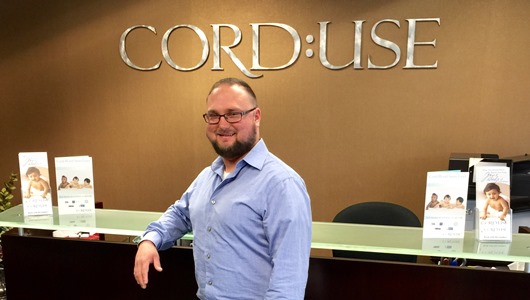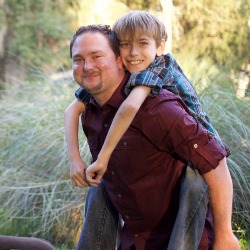Вы здесь
Interview with Matt Farrow, Recipient of World's 1st Cord Blood Transplant

Matthew Farrow, then a 5 year old boy with Fanconi anemia, received the world's first cord blood transplant on 6 Oct. 1988. The pioneering medical event was an international effort: Matthew came from North Carolina USA, his donor was his newborn baby sister, the American scientist who stored the cord blood was Dr. Hal Broxmeyer, and the transplant was performed at the French Hôpital Saint-Louis in Paris, where his physician was Dr. Eliane Gluckman. Matt is now 32 years old, married, and a father.
Matt, why do you do public outreach?
My goal is to share my story to help increase awareness and understanding of cord blood. There are so many people who don't really know the importance of it.
From your own experiences talking to patients and their families, what do you think are the key things that they should know about cord blood transplants?
I mostly talk to families with Fanconi Anemia (FA) because that is my diagnosis. My little sister's cord blood cured me from bone marrow failure caused by FA and that allowed me to grow up and become an adult. I encourage families of young kids who have gone through transplants, and show them that patients can grow up, have a family, and live a normal life.
Matt, you now work for a hybrid public/private cord blood bank that is directed by some of the leading doctors in cord blood transplantation. Can you tell us a bit about your work?
It is an honor to be able to work with a company that is led by the pioneers in this field. These doctors played a huge part in my life. I work as a patient advocate and I am able to go to public events and hospitals to share from my patient perspective the importance of cord blood. When I am not traveling, I work in the corporate office where I assist with the day to day operations of the cord blood bank. I do a lot of inventory management and warehouse upkeep. I do all of the ordering, for example I order all the supplies that go into the cord blood collection kits, both for collecting public donations and for family banking.
As a spokesperson for cord blood awareness, you have traveled to medical conferences, testified to politicians, and appeared at public events like NASCAR races. What was the most exciting experience you have had as a spokesperson?
I love doing these events, but my most exciting experience would have to be meeting kids that have had a cord blood transplant, like Rachel Lynn Smith who was a patient of Dr. Kurtzberg's who had a cord blood transplant for Blackfan-Diamond Anemia. Children like Rachel inspire me to keep going and the people that I meet touch my heart.
Even though you are a celebrity in the cord blood community, the day to day reality is that you are a regular guy trying to make ends meet and raise a family. Do you have any advice for transplant survivors trying to find a "new normal"?
 I've been very blessed that I havn't had long-term side effects from my cord blood transplant. Since I was so young when I had my transplant, living with that is all I ever knew. I was just a kid that wanted to play and get dirty and be like the other kids. After my transplant it took me a while to learn that it was OK to get dirty. So my advice would have to be that it is going to take time to adjust and to not dwell on the bad parts of the process. It is easy to ask "Oh, why me?" and I am sad that many of my friends have passed away. It took me a much longer time to realize that I had to focus on the future and really start living. G-d kept me here for a reason.
I've been very blessed that I havn't had long-term side effects from my cord blood transplant. Since I was so young when I had my transplant, living with that is all I ever knew. I was just a kid that wanted to play and get dirty and be like the other kids. After my transplant it took me a while to learn that it was OK to get dirty. So my advice would have to be that it is going to take time to adjust and to not dwell on the bad parts of the process. It is easy to ask "Oh, why me?" and I am sad that many of my friends have passed away. It took me a much longer time to realize that I had to focus on the future and really start living. G-d kept me here for a reason.
Matt, you appeared in a movie, Celebrating a Second Chance at Life - The history of Blood and Marrow Transplantation, that was produced by the patient support organization BMTinfonet. The movie featured some footage of you as a 5 year old in the hospital in Paris (minute 15). What do you tell your own son about those experiences?
Elijah will be twelve this November. We talk all the time about what I had to go through, how the transplant process was different from the way it is now, and I share with him little stories of the things that I can remember. For example I had to stay inside a plastic bubble and I could not have contact with anyone. I had to be sick by myself when all I wanted was to be held by my mom. When my parents came into the room they had to be completely gowned up. Even today, patients are in rooms with posiive air pressure instead of being inside bubbles, but parents still have to gown up and wear gloves and there is always a barrier when they touch their children.
Elijah is very proud of me and very proud to share who I am and how many lives have been saved because of his dad's experience as the first patient.
Many people still are not very aware or informed about cord blood stem cells and banking options. What do you think the cord blood community should do about this?
I think there should be a stronger message educating the public on the truth about cord blood and cord blood stem cells. I feel there is too much negative energy in the media about embryonic stem cells and the public is not hearing enough about cord blood stem cells. This leaves an impression in people's minds that stem cells are a negative thing. I was in a fast food restaurant one day and I overheard one customer tell another that cord blood banking is all a scam, so I went over and introduced myself. We need to get out more positive messages about cord blood stem cells.
I wish we had a TV presence in the cord blood field. We should have public service commercials about cord blood banking.
I think a lot of doctors don't explain cord blood options to expectant parents as well as they could, so better education for doctors would be helpful.


